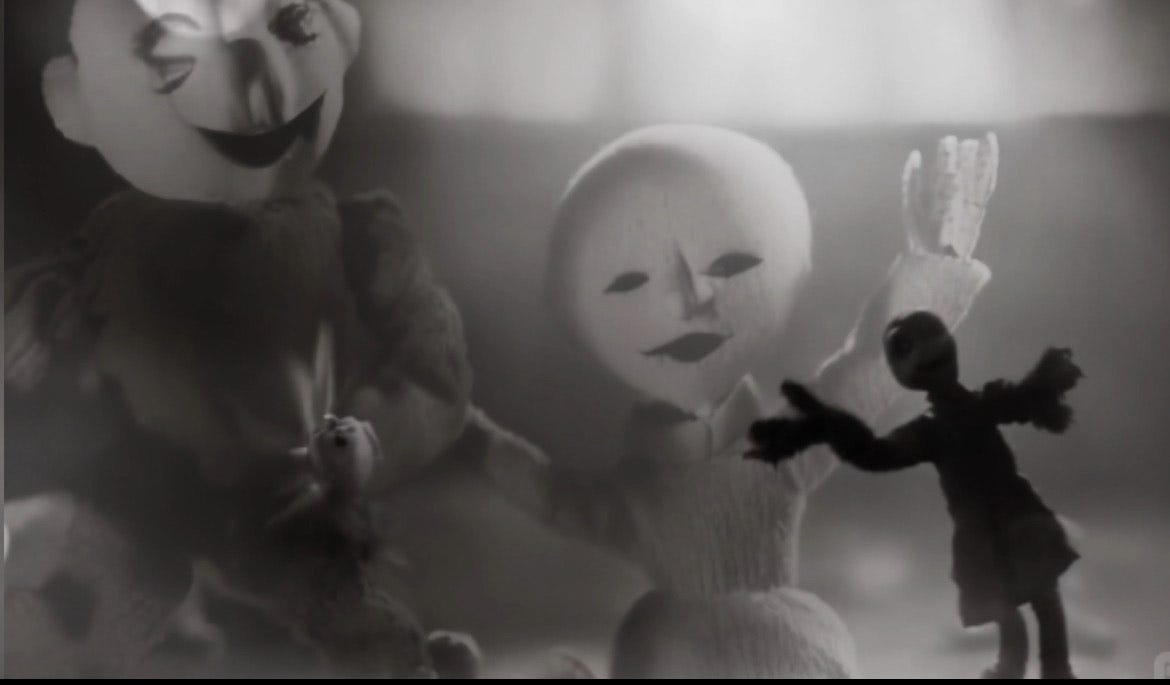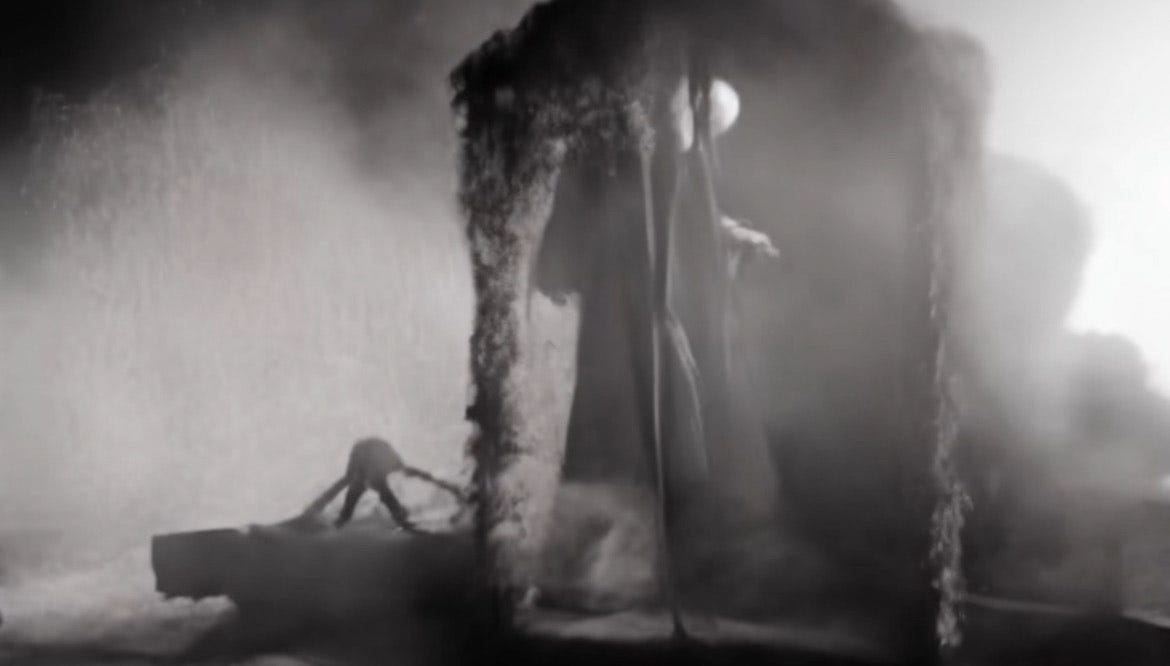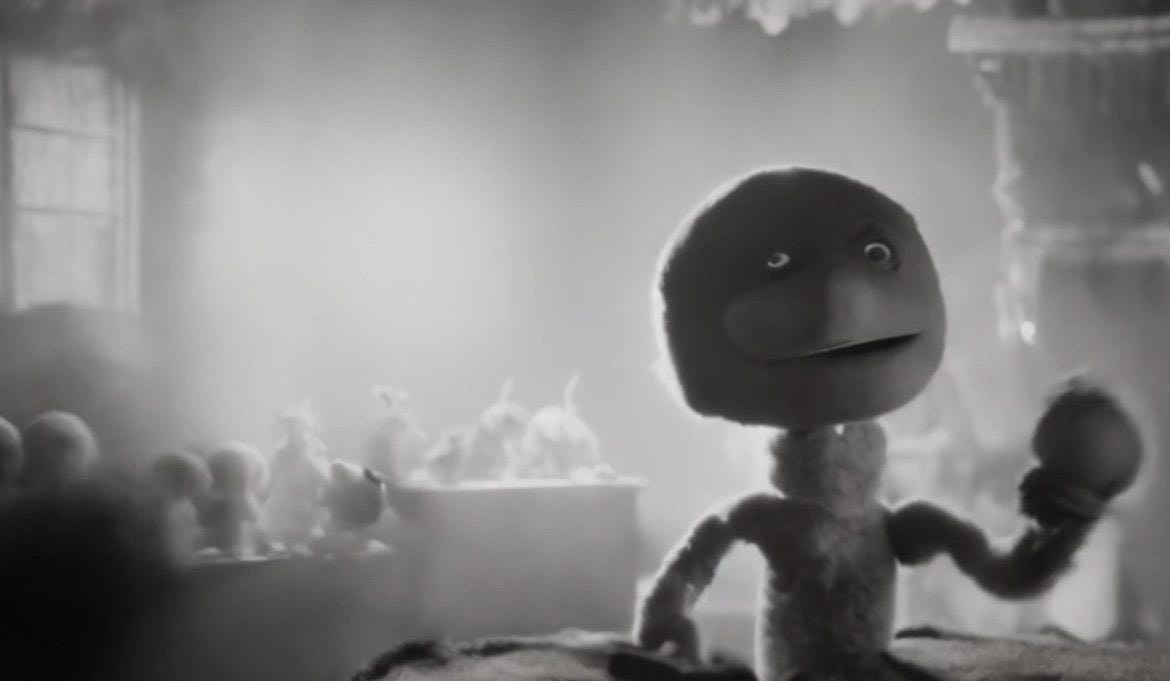Spinning in the Wildness: Phantom Requiem
(2024)
Phantom Requiem, a five minute short by Zazie Productions, is a nightmare, but an incredibly detailed, specific kind of nightmare. The music, which is often structured into layers of repeating melodic motifs, starts off in a gothic mood, with strings, organ, and church bells. We’re in a constantly shifting, black and white world, a world populated by grotesquely smiling finger puppets. But the smiles smeared onto the faces of these puppets aren’t happy smiles, they’re maniacal, terrified, but mostly chillingly blank, like smiley face buttons. Above all, they are deeply dissociated, the blank, painless smiles of someone who has checked out of this plane of reality, and short-circuited pain by fragmented himself into these multiple transitory disguises.
In keeping with the gothic mood, the constantly shifting setting seems to be at times a crumbling church, at times a neglected graveyard, or an abandoned construction site, a vacant lot at 2 am, or an interrogation chamber. We never get a clear handle on where we are, because the relentlessly seething visual surface of the film is peppered with lightning speed edits, veering and swooping camera moves, and perpetual fog mixed with shifting depth of field.
The grainy, foggy black and white textures, with their lurid lighting and shadows, certainly recall silent horror films of the Murnau era, perhaps as re-mixed under the hallucinations of some badly misfiring psychedelics. The horror film references build up, as more shadowy, indistinct figures crowd into the frame, which might be mad scientists, monsters, or weird, dancing mushroom caps. We occasionally glimpse fields of clock faces, the dials spinning wildly, as we float, unmoored from both space and time.
The main activity of the puppets, as far as we can discern it at all in the swirling rush of imagery, is dancing. The gothic trappings suggest that they could be engaged in a satanic ritual, but perhaps they are simply celebrating their complete liberation from rational thought, from ordinary reality.
The imagery becomes increasingly biological, as if we are now watching dancing ganglions and neurons. A melting ballerina dances forlornly on a slowly rotating turntable. And then, abruptly, it is over. The film has no discernible structure or development, but simply maintains its fever-pitch of hysteria and dread throughout its duration.
What lies underneath this unrelenting nightmare? The film is haunted, above all, by a sense of being mentally absent. The consciousness which has spawned this fragmented landscape of blissed-out zombies, dancing themselves into the grave, seems desperate to escape, not simply from reality, but from rational thought itself. The death being mourned here is the death of the self. What’s left resembles dust motes, drifting through the moonlight: wraith-like phantoms, left-over fragments of terror, numbed out by the chaos and meaninglessness. If everything is as disordered and violent as it is here, it seems to absolve the self of any obligation to make rational choices, to be compassionate, to connect with others.
The extreme nihilism of this vision is constantly undercut, in a way, by the dazzling technical skills of Zazie Kanwar-Torge, the filmmaker, whose meticulous attention to detail informs every frame. While the film constantly references horror film tropes, the originality of the imagery is startling, and Kanwar-Torge has painstakingly assembled these layers of imagery and music into a gushingly assaultive onslaught with finesse and precision. While the wild, despairing quality of the film suggests that the artist is familiar with some of the lowest, rock-bottom points a human being can suffer through, his cinematic and musical command speak of an artist able to harness such an experience and bring it to life, in all its complexity. The film’s short duration and lack of development mean that it is limited to a poetic representation of this mental experience, and Kanwar-Torge refrains from placing the experience into any larger story or context. As such, the film offers the viewer no excuse, no explanation, no framework for this visit to the Dark Side, just a short opportunity to spin, helpless, in the wildness. You will feel chill winds blowing through you for a long while after your five minutes with this powerful little film.
My articles on experimental film are freely available to all, but are supported by monthly and annual donations from readers. Please consider becoming a paid subscriber to support my work. Thank you.





This is the director, composer, sound designer, and creator of the film. I can actually give you my step-by-step process. Alongside, my intent.
Side note: I am 19 years old, have severe/chronic mental health issues, $300 budget, and stand in for an entire production team.
Given the scale of what I was trying to do, I feel no shame in optimizing parts of my workflow—especially motion and rendering—using modern tools where it made sense.
Certain transitions, slight gestures, or environmental movement were enhanced or assisted with AI-driven interpolation or motion mapping, but every decision was directed and shaped by hand.
What could be interpreted “numbness” or “meaninglessness” might actually be the residue of derealization episodes I was actively moving through while creating it.
If the film feels uncanny or disembodied, that’s not because it was churned out by an algorithm—it’s because that’s the condition I live with, and this is what it looks like translated into light, movement, and sound.
First: the faces. The “punch-out eye voids” and fixed-mouthed expressions were a direct nod to early 20th-century puppetry, particularly Czech and German clay masks used in children’s programming—combined with my own low-poly 3D modeling in Blender using the Decimate modifier to purposely reduce mesh fidelity. Because I paired this with physically incorrect lighting falloffs (using an inverse square curve mapped onto a false volumetric shadow), the result ends up mimicking what people associate with neural inpainting artifacts or AI “face glitches.”
Second: the characters’ staccato micro-movements, especially in the hallway and puppet congregation scenes, were hand-keyed on 3s or 4s, then slightly interpolated using RIFE (Real-Time Intermediate Flow Estimation)—an AI-based frame interpolation tool—not to fake realism, but to let me time the movements precisely across audio events. In other words, I generated real motion and then used AI to fine-tune the in-betweens for consistency, not creativity. It’s an optimization tool in my pipeline—not a generative engine.
Third: some of the background textures (like the smudged chalk wall or melted wallpaper behind the clock) were generated from high-resolution scans of hand-drawn ink blots, which I then iteratively processed through StyleGAN-2 for texture variation, mostly to save time on redundant background frames. These were static, not motion elements—but I suspect viewers unfamiliar with those techniques might interpret that smooth, unnaturally recursive texture consistency as a telltale sign of generative AI. In fact, it’s the opposite: it’s an analog image reprocessed to look recursive.
Fourth: It could be mistaking motion latency blending (which I created using vector blur passes and smearing effects in After Effects with displacement maps) for latent diffusion temporal smoothing.
I did what needed to be done to translate the internal into the visible. If you see artifice, look again—it might be precision mistaken for distance. Or perhaps discomfort mistaken for detachment.
If you’re still unsure, reach out. If you’re intrigued, I’d love to talk. If you think it’s bullshit, let’s dissect the carcass together.
I’m open to feedback, commissions, collaborations, and critique.
About the rendering techniques, the puppet weight maps, the temporal interpolation tricks I used to save render time without compromising feel.
I’ll talk about my music process, my influences, my error logs, my obsessive lighting tests.
I’ll walk you through it all, because I’ve got nothing to hide and everything to say. I genuinely love what I do! :)
Hi David, I’m a fan of your work and blog. However, this review left me a bit bewildered. Even more than the film! Maybe I am mistaken, but it feels like the film is composed entirely of Ai generated videos. If this is the case, it makes it hard to accept your observations about the filmmaker’s obsessive attention to detail, precision, and technical use of puppetry. I could certainly be wrong and the craftsmanship of the film is pretty far out. But, my guess, is all the meaninglessness and numbness you’re picking up on is just a product of Ai’s output and not the filmmaker’s intentions.